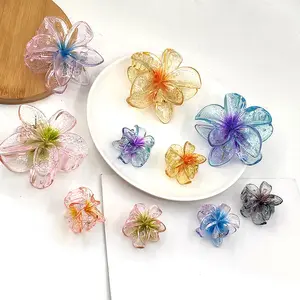Popular en tu industria






Abrazadera de tubo de escape Universal Vband, abrazadera de acero inoxidable de 3,5 pulgadas con banda en V
EUR 6.31 - EUR 7.70
Pedido mínimo: 10 conjuntos






Alicates hidráulicos de metal y plástico doble, juego de alta resistencia, máquina de fabricación de acero inoxidable, abrazadera de manguera
EUR 0.0186 - EUR 0.0742
Pedido mínimo: 10 piezas






TANHO TTD ABC cable ignífugo 25-95 mm2 conectores de punción de aislamiento eléctrico 1KV abrazaderas aisladas para perforar
EUR 0.6026 - EUR 0.7324
Pedido mínimo: 100 piezas







Abrazadera hidráulica de tubería de servicio pesado de liberación rápida Abrazadera de manguera de clip de tipo americano Soporte de tubería de servicio pesado Abrazadera dividida forrada de goma
EUR 0.2781
Pedido mínimo: 1000 piezas
Envío por pieza: EUR 0.8992







Abrazadera de manguera de acero inoxidable, Perno doble de bloqueo de alta resistencia al calor, ms 27mm a 35 mm
EUR 0.0186 - EUR 0.0742
Pedido mínimo: 10 piezas
Envío por pieza: EUR 0.927






Abrazadera de haz de acero de fundición, M6, M8, M10, M12, M14, M16, China
EUR 0.2781
Pedido mínimo: 1000 piezas
Envío por pieza: EUR 4.66







Abrazadera de manguera resistente con perno en T de acero al carbono Chapado en zinc/acero inoxidable 2024 PUX
Listo para enviar
EUR 0.1391 - EUR 1.21
Pedido mínimo: 100 paquetes
Envío por pieza: EUR 81.60






Abrazadera de acero para panel Peri, abrazadera de corte BFD
EUR 2.79 - EUR 3.25
Pedido mínimo: 1000 piezas






Lock form work clamp panel form work bfd lock/form work clamp lock steel wst galvanized pressed cn;heb
EUR 2.32 - EUR 9.27
Pedido mínimo: 1000 conjuntos






Abrazadera BFD de acero para trabajos de construcción, pieza de sujeción de acero
EUR 9.27 - EUR 13.91
Pedido mínimo: 300 piezas
Envío por pieza: EUR 8.32






Venta directa de fábrica de China Peri usado abrazadera de viga de encofrado BFD de bloqueo universal ajustable
EUR 7.00 - EUR 8.30
Pedido mínimo: 1000 piezas






Peri-abrazadera de empalme de hormigón para pared, acoplador de alineación de circuito impreso, compatible con Trio, BFD
EUR 0.547 - EUR 0.9178
Pedido mínimo: 1000 piezas





ZEEMO-abrazadera de Panel Peri de bloqueo BFD de alta resistencia, suministro de fábrica, galvanizado, para trabajos de construcción
EUR 4.45 - EUR 4.73
Pedido mínimo: 2 piezas






Abrazadera de panel de acoplador de alineación BFD, material de construcción, formwork
EUR 7.40 - EUR 8.21
Pedido mínimo: 2000 piezas
Envío por pieza: EUR 16.61


Concrete wall formwork lock clamp alignment clamps for all panel connections peri maximo trio and and rundflex
EUR 8.81 - EUR 9.27
Pedido mínimo: 2000 piezas






Peri Trio-acoplador de alineación de bloqueo de hormigón, abrazadera BFD, Compatible con muro de cemento
EUR 6.49 - EUR 6.68
Pedido mínimo: 1000 piezas
Envío por pieza: EUR 111.73






Forjado cuñas para encofrado BFD abrazaderas o dominó abrazaderas
EUR 1.40 - EUR 1.86
Pedido mínimo: 1000 piezas






ANDAMIO LINYIQUEEN Abrazaderas de encofrado Doka BFD ajustables Abrazadera de tubo de bloqueo de acero galvanizado S355JR Abrazadera de viga
EUR 8.81 - EUR 11.13
Pedido mínimo: 2 piezas






Abrazadera de panel acoplador de alineación, material de construcción
EUR 0.927 - EUR 1.12
Pedido mínimo: 1000 metros






Accesorios de encofrado Abrazadera Bfd/Abrazadera de alineación ajustable/Abrazadera Peri Domino
EUR 0.6489
Pedido mínimo: 3000 piezas
Envío por pieza: EUR 3.33






Abrazadera BFD de acero y hormigón, accesorio de alta calidad, 4,3 kg, Máximo, beras, 26cm
EUR 1.35 - EUR 1.86
Pedido mínimo: 10000 piezas
Envío por pieza: EUR 8.74






Swing bolt or band clamp 24 elements 732 720TPH BFD BFM 1400-24F SS Bag Filter
EUR 27.81 - EUR 37.08
Pedido mínimo: 1 pieza
Envío por pieza: EUR 43.99



Abrazadera de encofrado de acero Bfd Lock Peri Panel Abrazadera de encofrado Abrazadera G
EUR 0.0186 - EUR 0.0464
Pedido mínimo: 1000 piezas






Andamios y construcción de encofrado de hormigón BFD C abrazadera 50mm Brasil andamio putlog abrazadera precio
EUR 0.4635 - EUR 0.927
Pedido mínimo: 1000 piezas
Envío por pieza: EUR 10.84






Clip de hormigón de resorte encofrado rápido abrazaderas de forma BFD abrazadera de andamio de tubería cruzada de acero inoxidable
EUR 0.7509
Pedido mínimo: 500 piezas


Wedge clamp 2.8kg formwork casted iron formwork tie system jd jd-frc11 gal.zinc cn;heb
EUR 2.67 - EUR 3.38
Pedido mínimo: 2000 piezas






Abrazaderas de cuña de barra de amarre para construcción, tuerca de ala de formo galvanizado de buena calidad, 15/17mm
EUR 0.3894 - EUR 0.5099
Pedido mínimo: 1 pieza






Kingbridge-abrazadera de bloqueo de cuña de Panel de alineación, abrazadera de cuña de acero para fabricación directa de fábrica
EUR 3.25
Pedido mínimo: 2000 piezas



Formwork accessory of peris trio bfd coupler with high steel grade and hot dip treatment
Listo para enviar
EUR 23.18
Pedido mínimo: 2 piezas
Envío por pieza: EUR 22.00






Acoplador de alineación de abrazadera de encofrado Trio BFD
EUR 9.27 - EUR 11.13
Pedido mínimo: 1000 conjuntos






Galvanized steel scaffolding and construction formwork bfd clamp for building construction and accessories
EUR 0.8343 - EUR 5.56
Pedido mínimo: 1000 piezas






Suit for formwork panel clamp peri bfd long l434 zb ss400+q345+45/etc support oem customized
EUR 9.27 - EUR 13.91
Pedido mínimo: 300 piezas
Envío por pieza: EUR 16.62












Abrazadera BFD de cuña de formización, precio de fábrica
EUR 0.4172 - EUR 0.8899
Pedido mínimo: 1000 piezas






Cerradura de encofrado de construcción Abrazadera de encofrado de acero Peri BFD
EUR 5.38 - EUR 7.61
Pedido mínimo: 500 metros cuadrados






Abrazadera de panel de alineación BFD, prensado, para Panel de marco, Trio de construcción
EUR 7.40 - EUR 8.21
Pedido mínimo: 2000 piezas
Envío por pieza: EUR 8.31






KEVA Peri trio-Accesorios de moldura de construcción, abrazadera de Panel prensado BFD
EUR 7.42 - EUR 11.13
Pedido mínimo: 1120 piezas
Categorías principales
Sobre abrazadera bfd
Alibaba.com ofrece los productos 291 abrazadera bfd. Una amplia variedad de opciones de abrazadera bfd está disponibles para usted, como por ejemplo de acero, de acero inoxidable y de metal. También puede elegir de pulgadas abrazadera bfd,así como de de soldadura abrazadera bfd.Y si abrazadera bfd es estándar.


























